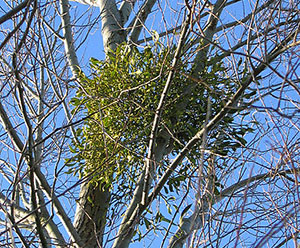Ho, Ho, Ho: The Mistletoe
Ho, Ho, Ho: The Mistletoe
By Bill Willis, Wildlife and Industry Together (WAIT) and Site Ecology Team (SET)
Janurary, 2016

Photo courtesy of Andrew Dunn
People are more likely to look down than up as they walk. Focused on a phone, you often might miss something exciting and remarkable right above your head. The next time you are walking from the South Parking lot to Rodbell, look up. You might see a clump of mistletoe in the willow oak.
How, why, and where does mistletoe grow?
This type of mistletoe (commonly known as “American Mistletoe”) is unmistakable, with thick, leathery, evergreen leaves, clumping ball-shaped growth form. It can be found on 100 different types of trees, including hickory, red maple, and oaks. As a partial parasite (a “hemiparasite”), it grows on the branches or trunk of a tree and actually sends out roots that penetrate into the tree and take up water and nutrients. However, the presence of mistletoe can indicate a diverse ecosystem.
If you brought mistletoe into your home during the holidays, take care, as the white berries poisonous and may cause lowered blood pressure and stomach and intestinal irritation if ingested.
Magic of Mistletoe
Mistletoe is most easily seen during the winter months when the trees are free of leaves. As it can appear to be the only living branch on the tree, it is often considered magical.
Ancient Celtic Druids would collect mistletoe growing on oak trees at summer and winter solstices and display it in their homes to bring prosperity; the timing of this collection would eventually influence the display of mistletoe at Christmas time. In the Middle Ages, Europeans hung branches of mistletoe from ceilings to ward off evil spirits and over house and stable doors to prevent the entrance of witches. Oak mistletoe was also believed to be able to extinguish fire, as a common belief was that mistletoe would grow after a tree was struck by lightning.
Kissing under the mistletoe was likely first associated with the Greek festival of Saturnalia, where mistletoe was believed to have the power to influence fertility. Later, in Scandinavia, mistletoe was considered a plant of peace, under which enemies could declare a truce or warring spouses kiss and make-up. The eighteenth-century English used mistletoe to create a holiday “kissing ball.”
As Europeans settled in North America, they transferred many long-standing cultural superstitions to the native version of mistletoe.
There are probably other clumps of mistletoe on campus. When you’re out for a walk, look up. You just might spot a bit of magic.



